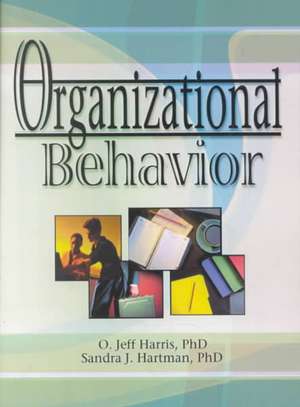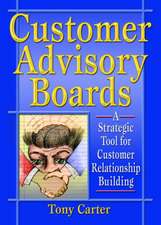Organizational Behavior
Autor Robert E. Stevens, David L. Loudon, O. Jeff Harris, Jr, Sandra J Hartmanen Limba Engleză Paperback – 24 oct 2001
An effective understanding of workplace behavior requires a solid grounding in both principles and practice. Organizational Behavior provides both. This comprehensive textbook uses realistic case examples, self-tests, and plentiful tables and figures to illustrate the principles of organizational behavior.
Each chapter begins by posing a difficult work situation, which may be a conflict, a problem with motivation, or an issue of diversity. Then it goes on to discuss the principles and theories that apply to the case, returning to it at times to see how various strategies work. The start-of-chapter problems catch students’interest, and the clear explications of theory give them the concepts they need to come up with innovative solutions.
The classic areas of ethics, problem employees, motivation, conflict, and organizational culture are amply covered, but Organizational Behavior also deals with areas too often neglected, including:
- the physical atmosphere of the workplace
- the effects of new technologies on workers
- the pitfalls and opportunities of globalization
- diversity and multiculturalism in the workplace
- both informal and formal organizational structure
- workplace gossip and the office grapevine
Preț: 265.49 lei
Preț vechi: 368.92 lei
-28% Nou
Puncte Express: 398
Preț estimativ în valută:
50.82€ • 55.22$ • 42.71£
50.82€ • 55.22$ • 42.71£
Carte tipărită la comandă
Livrare economică 21 aprilie-05 mai
Preluare comenzi: 021 569.72.76
Specificații
ISBN-13: 9780789015006
ISBN-10: 0789015005
Pagini: 496
Dimensiuni: 152 x 212 mm
Greutate: 0.73 kg
Ediția:1
Editura: Taylor & Francis
Colecția Routledge
Locul publicării:Oxford, United Kingdom
ISBN-10: 0789015005
Pagini: 496
Dimensiuni: 152 x 212 mm
Greutate: 0.73 kg
Ediția:1
Editura: Taylor & Francis
Colecția Routledge
Locul publicării:Oxford, United Kingdom
Cuprins
Contents
- Preface
- Chapter 1. Human Behavior at Work--With an Emphasis on Ethics
- Objectives
- A Case to Consider: The “Best Seller”
- Management Perspectives
- Ethical Issues and Social Responsibility
- Employee Dishonesty and Theft
- Summary
- Questions to Consider
- Chapter Case: Decisions, Decisions
- Glossary
- Chapter 2. Diversity and Inequity in the Workplace
- Objectives
- A Case to Consider: Ellen Crenshaw--A Dissatisfied Banker
- Four American Generations
- Gender: Women As a Minority
- Older Workers As an Age Minority
- Younger Employee--Their Strengths and Weaknesses
- Minorities Based upon Race
- What Can Be Done?
- Workers with Disabilities
- Employees with AIDS
- Steps Toward Equity
- Summary
- Questions to Consider
- Chapter Case: A New Breed of Nurse
- Glossary
- Chapter 3. Globalization and Its Effects
- Objectives
- A Case to Consider: I Need Advice!
- A Managerial Challenge--The Multinational Movement
- Cultural Values
- Societal Procedures and Methods
- Multinational Language and Communication
- Summary
- Questions to Consider
- Chapter Case: Case of the Wrong Mangoes
- Glossary
- Chapter 4. Organizational Culture--The Planned, Structured Side
- Objectives
- A Case to Consider: Fairfields Nursing Home
- The Culture of the Organization
- The Right Structure for an Organization to Have
- Contemporary Happenings in Organizational Composition
- Summary
- Questions to Consider
- Chapter Case: Changes at Barbados Airlines
- Glossary
- Chapter 5. Organizational Culture--The Informal Organization and Power and Politics
- Objectives
- A Case to Consider: The Three Night Custodians
- Organizational Culture and Cultural Realities
- Overcoming a Faulty Culture
- Management's Relationship to the Informal Organization
- Power: For Managers Only? A Dirty Word?
- Summary
- Questions to Consider
- Chapter Case: Marley Printing Company
- Glossary
- Chapter 6. What Good Are Groups, Anyway?
- Objectives
- A Case to Consider: O'Keefe--The Director Who Wants a Group Decision
- Formal Groups and Teams
- Traditional Groups and Teams
- Nontraditional Groups
- Team Building and Problem Solving
- Summary
- Questions to Consider
- Chapter Case: The Arrogant Architects
- Glossary
- Chapter 7. The Physical Surroundings of the Workplace
- Objectives
- A Case to Consider: The Superior Insurance Company
- Effects of Nature--Temperature and Humidity
- The Impact of Visual Stimuli
- Auditory Factors--The Effects of Noise
- Physical Location and Placement
- The Status Impact of Physical Climate
- Smoking in the Workplace
- Summary
- Questions to Consider
- Chapter Case: The Casino Crazies
- Glossary
- Chapter 8. Perception and the Individual
- Objectives
- A Case to Consider: David Addison--An Unexpected Success Story
- What You See Is What You Get
- Perceptions About Self and Others
- Role Perception
- Perception of Who Controls Outcomes (Locus of Control)
- The Pygmalion Effect--Improving Performance Through Perception
- Summary
- Questions to Consider
- Chapter Case: The State Highway Review Board
- Glossary
- Chapter 9. Personal Needs in the Workplace
- Objectives
- A Case to Consider: Lisa Lanigan, CPA
- Can My Job Give Me What I Want?
- Needs Theories
- Specific Human Needs
- The Degree of Need Fulfillment and the Urgency of Needs
- Discovering the Current Needs of Workers
- Summary
- Questions to Consider
- Chapter Case: Motivational Problems at the Environmental Improvement Unit
- Glossary
- Chapter 10. The Role of Leadership in the Organization
- Objectives
- A Case to Consider: Ted Gunderson--The Construction Supervisor
- How We Got Where We Are Today
- Flexible L
Notă biografică
Robert E Stevens, David L Loudon, O. Jeff Harris Jr, Sandra J. Hartman
Descriere
This comprehensive textbook uses realistic case examples, self-tests, and plentiful tables and figures to illustrate the principles of workplace behavior. The classic areas of ethics, motivation, conflict, and organizational culture are amply covered, while special attention is paid to such current issues as the effects of new technologies on workers, the pitfalls and opportunities of globalization and multiculturalism, the physical environment of the workplace, and the role perception plays in effective management. A teacher's manual with lecture notes and a test bank is also available.
To view an excerpt online, find the book in our QuickSearch catalog at www.HaworthPress.com.
To view an excerpt online, find the book in our QuickSearch catalog at www.HaworthPress.com.






















